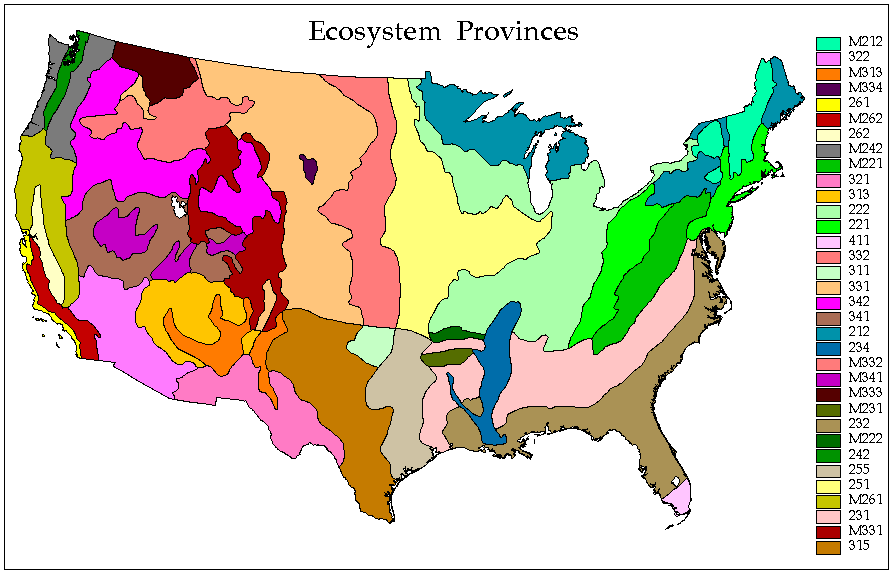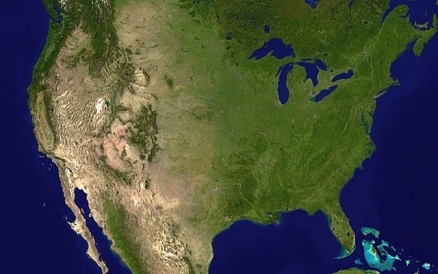Ecoregions of the United States (Bailey)
This article is part of the Ecoregions Collection
Dr. Robert G. Bailey is a geographer for the U.S Forest Service who developed one of the most widely used systems to define, describe, and map the world's ecoregions. It is a hierarchical system with four levels: domains, divisions, provinces and sections. Domains are the largest geographic levels and are defined by climate, e.g., polar domain, dry domain, or humid tropical domain. Domains are split into smaller divisions that are defined according climate and vegetation, and the divisions are split into smaller provinces that are usually defined by their major plant formations. Some divisions also include varieties of "mountain provinces" that generally have a similar climatic regime to the neighboring lowlands but show some altitudinal zonation, and they are defined according to the types of zonation present. Provinces are divided into sections, which are defined by the landforms present.
Below are links to descriptions, images and maps of the ecoregions of the United States as defined by the Bailey system. These descriptions were first published in 1978; the versions used here are from the 1995 revision. More detailed descriptions of the Bailey system are available at the ecoregion web site of the U.S Forest Service.
Bailey's Ecoregion Classification of the United States
 Ecosystem provinces of the United States. Source: U.S. Forest Service
Ecosystem provinces of the United States. Source: U.S. Forest Service
100 Polar domain
120 Tundra Division
124 Arctic Tundra Province
125 Bering Tundra (Northern) Province
126 Bering Tundra (Southern) Province
M120 Tundra Division - Mountain Provinces
M121 Brooks Range Tundra - Polar Desert Province
M125 Seward Peninsula Tundra - Meadow Province
M126 Ahklun Mountains Tundra - Meadow Province
M127 Aleutian Oceanic Meadow - Heath Province
131 Yukon Intermontane Plateaus Tayga Forest
135 Coastal Trough Humid Tayga Province
139 Upper Yukon Tayga Province
M130 Subarctic Division - Mountain Provinces
M131 Yukon Intermontane Plateaus Tayga - Meadow Province
M135 Alaska Range Humid Tayga - Tundra - Meadow
M139 Upper Yukon Tayga - Meadow Province
212 Laurentian Mixed Forest Province
M210 Warm Continental Division - Mountain Provinces
M212 Adirondack-New England Mixed Forest - Coniferous Forest - Alpine Meadow Province
221 Eastern Broadleaf Forest (Oceanic) Province
222 Eastern Broadleaf Forest (Continental) Province
M220 Hot Continental Division - Mountain Provinces
M221 Central Appalachian Broadleaf Forest - Coniferous Forest - Meadow Province
M222 Ozark Broadleaf Forest - Meadow Province
231 Southeastern Mixed Forest Province
232 Outer Coastal Plain Mixed Forest Province
234 Lower Mississippi Riverine Forest Province
M230 Subtropical Division - Mountain Provinces
M231 Ouachita Mixed Forest - Meadow Province
240 Marine Division
242 Pacific Lowland Mixed Forest Province
M240 Marine Division - Mountain Provinces
M242 Cascade Mixed Forest - Coniferous Forest - Alpine Meadow Province
250 Prairie Division
251 Prairie Parkland (Temperate) Province
255 Prairie Parkland (Subtropical) Province
261 California Coastal Chaparral Forest and Shrub Province
261A Central California Coast
261B Southern California Coast
262 California Dry Steppe Province
262A Great Valley
263 California Coastal Steppe, Mixed Forest, and Redwood Forest Province
263ANorthern California Coast
M260 Mediterranean Division - Mountain Provinces
M261 Sierran Steppe - Mixed Forest - Coniferous Forest - Alpine Meadow Province
M261A Klamath Mountain M261B Northern California Coast Ranges M261C Northern California Interior Coast Ranges M261D Southern Cascades M261E Sierra Nevada M261F Sierra Nevada Foothills M261G Modoc Plateau
M262 California Coastal Range Open Woodland-Shrub-Coniferous Forest - Meadow Province
M262A Central California Coast Ranges
M262B Southern California Mountains and Valleys
300 Dry Domain
310 Tropical/Subtropical Steppe Division
311 Great Plains Steppe and Shrub Province
313 Colorado Plateau Semidesert Province
315 Southwest Plateau and Plains Dry Steppe and Shrub Province
M310 Tropical/Subtropical Steppe Division - Mountain Provinces
M313 Arizona-New Mexico Mountains Semidesert-Open Woodland - Coniferous Forest - Alpine Meadow Province
320 Tropical/Subtropical Desert Division
321 Chihuahuan Semidesert Province
322 American Semidesert and Desert Province
322A Mojave Desert
322B Sonoran Desert
322C Colorado Desert
331 Great Plains-Palouse Dry Steppe Province
332 Great Plains Steppe Province
M330 Temperate Steppe Division - Mountain Provinces
M331 Southern Rocky Mountain Steppe - OpenWoodland - Coniferous Forest - Alpine Meadow Province
M332 Middle Rocky Mountain Steppe - Coniferous Forest - Alpine Meadow Province
M333 Northern Rocky Mountain Forest-Steppe - Coniferous Forest - Alpine Meadow Province
M334 Black Hills Coniferous Forest Province
341 Intermountain Semidesert and Desert Province
341D Mono
341F Southeastern Great Basin
342 Intermountain Semidesert Province
342B Northwestern Basin and Range
M340 Temperate Desert Division - Mountain Provinces
M341 Nevada-Utah Mountains Semidesert - Coniferous Forest - Alpine Meadow Province
410 Savanna Division
M410 Savanna Division - Mountain Provinces
M411 Puerto Rico Province
M420 Rainforest Division - Mountain Provinces
M423 Hawaiian Islands Province
Further Reading
- Bailey, Robert G. 2002. Ecoregion-Based Design for Sustainability. Springer-Verlag. New York, New York. 240pp., 100 illus. ISBN 0-387-95430-9
- Bailey, Robert G. 1998. Ecoregions: The Ecosystem Geography of the Oceans and the Continents. Springer-Verlag. New York, New York. 192pp., 107 illus., 10 tables. ISBN 0-387-98305-8
- Bailey, Robert G. 1996. Ecosystem Geography. Springer-Verlag. New York, New York. 216pp., 122 illus., 14 tables. ISBN 0-387-94586-5
- U.S. Forest Service, Rocky Mountain Research Station, Description of the Ecoregions of the United States, Accessed 1 May 2009.
- U.S. Forest Service, Rocky Mountain Research Station, Ecoregion Home Page, Accessed 1 May 2009

